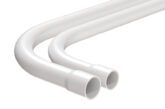
In this article, the technical experts at NAPIT examine the practice of burying cables.
Two of the most commonly asked questions in this industry must be: “Can I bury this cable?” and “How deep does it need to go?”
The answer to both questions will vary wildly based on the cable type, the installation, the external influences, the traffic over it (both motorised and on foot) and the need for future access.
Some cables are designed specifically to be buried and have their own extra protection, such as steel wire armoured (SWA), as displayed in Fig 1. Other cable types can be buried, but may need a little extra protection to ensure they remain as free as possible from damage.
Where cables have no external protection, such as the armouring of an SWA cable, we have to take a different approach to protect the inner cores from being buried and being subjected to excessive stress. We can still bury them, but we have to protect them either by way of some form of ducting, conduit or a protected channel.
In reality, cables in ducting, conduit and protected channels, although buried, are usually accessible for maintenance or completely encased in concrete – see BS 7671 Appendix 4, Table 4A2 and reference methods 59 and 60, respectively.
We usually see protected channels in plant rooms and where cables enter under a distribution board, and we must ensure that we have access to them to carry out future maintenance, alterations and possible repairs.
Where long runs of buried cable are anticipated and the area is likely to have either foot or motorised traffic over it, SWA is the go-to cable. It was designed for this very purpose, and where installed correctly, it meets all of the requirements for water ingress protection and object damage caused by stress loadings from aggregate buried on top of it.
Twin and earth in a hose pipe are unlikely to fit the mechanical damage or water submergence requirements; remember, the ground is an unforgiving environment, and twin and earth cables often don’t fare well in it.
Plus, when digging, if a client comes across a hose pipe, many people take for granted that it’s just an old, buried, unwanted hose pipe and crash through it with a shovel or fork – that’s exactly what we don’t want to happen.
What do the Regulations say about burying cables, generally?
As a general rule, BS 7671 doesn’t give much advice or particulars other than Regulation 522.8.10 stating that a cable must be adequately protected and at a depth unlikely to lead to a disturbance during natural overground traffic and use.
Traffic doesn’t necessarily mean vehicular in this instance and can be anything from general footfall to gardening. Along with the depth of a buried cable, it needs to be adequately identified using a marker tape or similar, see Fig 2. As a general rule, marker tape should be laid approximately 150 mm from the finished surface level.
Where an SWA cable is buried directly in the ground, it should be backfilled with a sand aggregate to help cushion and protect it from the effects of larger aggregates damaging it when buried, as shown in Fig 3.
So that’s about it from a general cable-burying perspective. BS 7671 leaves pretty much everything open to designers to put together an adequate system based on the risks that are present in different installations and their uses.
What are the specific Regulations for buried cables?
When we look at the risk an installation and its use may give rise to, BS 7671 only looks at four different areas where specific cable depth provisions are given.
These areas are covered in Part 7 special locations, which include:
705: Agricultural and horticultural premises
708: Electrical installations in caravan/camping parks and similar locations
709: Marinas and similar locations
730: Onshore units of electrical shore connections for inland navigation vessels.
We can see the requirements for each of these special locations more clearly when we look at them in a table which breaks down each Regulation specifically. See Table 1 for minimum buried cable depth requirements.
Along with the general Regulation for buried cables, 522.8.10, and the special locations listed earlier in this article, guidance is also available in BS 7671 Appendix 4 Table 4A2 installation and reference methods.
Table 4A2 gives various reference methods, clarifies how to construct the different systems, and refers to the correct current carrying capacity that any cable conductors would then be subjected to.
Conclusion
So, in conclusion, there is no simple answer, depth, or method. It is really down to the designer, the installation, its use, and any risks that may be prevalent.
The one figure that we all agree on as an industry, is that any buried cable should be at a minimum depth of 0.5 m, where a special location requirement does not cover it. This is because with light hand digging, such as in a garden, etc., we may subject a cable (even an armoured one) to damage at depths of less than 0.5 m.
For more information on NAPIT Scheme Registration, click here













